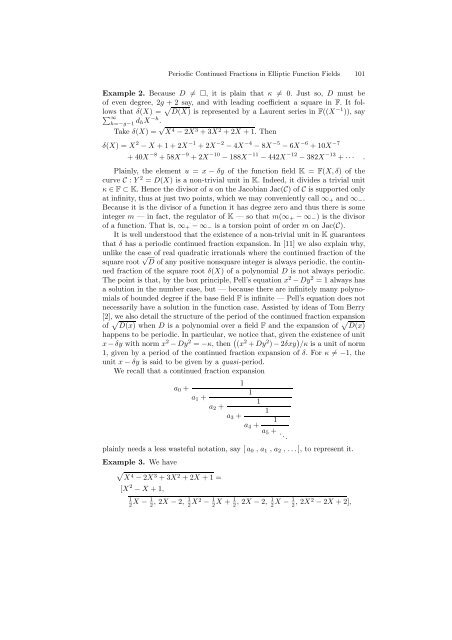Periodic Continued Fractions in Elliptic Function Fields - Macquarie ...
Periodic Continued Fractions in Elliptic Function Fields - Macquarie ...
Periodic Continued Fractions in Elliptic Function Fields - Macquarie ...
Create successful ePaper yourself
Turn your PDF publications into a flip-book with our unique Google optimized e-Paper software.
<strong>Periodic</strong> <strong>Cont<strong>in</strong>ued</strong> <strong>Fractions</strong> <strong>in</strong> <strong>Elliptic</strong> <strong>Function</strong> <strong>Fields</strong> 101<br />
Example 2. Because D = , it is pla<strong>in</strong> that κ = 0. Just so, D must be<br />
of even degree, 2g +2 say, and with lead<strong>in</strong>g coefficient a square <strong>in</strong> F. Itfollows<br />
that δ(X) = D(X) isrepresented by a Laurent series <strong>in</strong> F((X−1 <br />
)), say<br />
∞<br />
h=−g−1 dhX −h .<br />
Take δ(X) = √ X4 − 2X3 +3X2 +2X +1.Then<br />
δ(X) =X 2 − X +1+2X −1 +2X −2 − 4X −4 − 8X −5 − 6X −6 +10X −7<br />
+40X −8 +58X −9 +2X −10 − 188X −11 − 442X −12 − 382X −13 + ··· .<br />
Pla<strong>in</strong>ly, the element u = x − δy of the function field K = F(X, δ) ofthe<br />
curve C : Y 2 = D(X) isanon-trivial unit <strong>in</strong> K. Indeed, it divides a trivial unit<br />
κ ∈ F ⊂ K. Hence the divisor of u on the Jacobian Jac(C) ofC is supported only<br />
at <strong>in</strong>f<strong>in</strong>ity, thus at just two po<strong>in</strong>ts, which we may conveniently call ∞+ and ∞−.<br />
Because it is the divisor of a function it has degree zero and thus there is some<br />
<strong>in</strong>teger m —<strong>in</strong>fact, the regulator of K —sothat m(∞+ −∞−) isthe divisor<br />
of a function. That is, ∞+ −∞− is a torsion po<strong>in</strong>t of order m on Jac(C).<br />
It is well understood that the existence of a non-trivial unit <strong>in</strong> K guarantees<br />
that δ has a periodic cont<strong>in</strong>ued fraction expansion. In [11] we also expla<strong>in</strong> why,<br />
unlike the case of real quadratic irrationals where the cont<strong>in</strong>ued fraction of the<br />
square root √ D of any positive nonsquare <strong>in</strong>teger is always periodic, the cont<strong>in</strong>ued<br />
fraction of the square root δ(X) ofapolynomial D is not always periodic.<br />
The po<strong>in</strong>t is that, by the box pr<strong>in</strong>ciple, Pell’s equation x 2 − Dy 2 =1always has<br />
a solution <strong>in</strong> the number case, but — because there are <strong>in</strong>f<strong>in</strong>itely many polynomials<br />
of bounded degree if the base field F is <strong>in</strong>f<strong>in</strong>ite — Pell’s equation does not<br />
necessarily have a solution <strong>in</strong> the function case. Assisted by ideas of Tom Berry<br />
[2], we also detail the structure of the period of the cont<strong>in</strong>ued fraction expansion<br />
of D(x) when D is a polynomial over a field F and the expansion of D(x)<br />
happens to be periodic. In particular, we notice that, given the existence of unit<br />
x − δy with norm x 2 − Dy 2 = −κ, then (x 2 + Dy 2 ) − 2δxy /κ is a unit of norm<br />
1, given by a period of the cont<strong>in</strong>ued fraction expansion of δ. Forκ = −1, the<br />
unit x − δy is said to be given by a quasi-period.<br />
We recall that a cont<strong>in</strong>ued fraction expansion<br />
1<br />
a0 +<br />
1<br />
a1 +<br />
1<br />
a2 +<br />
1<br />
a3 +<br />
1<br />
a4 +<br />
a5 + . ..<br />
pla<strong>in</strong>ly needs a less wasteful notation, say [ a0 ,a1 ,a2 , ...], to represent it.<br />
Example 3. We have<br />
<br />
X4 − 2X3 +3X2 +2X +1=<br />
[X 2 − X +1,<br />
1 1<br />
1<br />
2X − 2 , 2X − 2,<br />
2X2 − 1<br />
2<br />
1<br />
1 1<br />
X + 2 , 2X − 2, 2X − 2 , 2X2 − 2X +2],

















